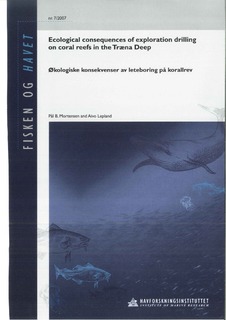| dc.description.abstract | Coral reefs, skeleton samples and bottom sediments in the vicinity of the hydrocarbon exploration test well in the Træna Deep have been studied to assess the ecological effects and "health status" of Lophelia coral reefs. The fieldwork was carried out in June 2005, providing skeleton and sediment samples from 33 locations, video-recordings from eight dives with Remotely Operated Vehicle (ROV), and data on water movement from three current meters located at different sites. Current velocity and direction were recorded over a period of six days. The velocity varied between 0 and 27 cm/s, with the weakest currents in the area close to the exploration drilling site, and the strongest currents at the reference site about 12 km southeast of the drilling site. The current pattern showed tidal influence with a strong westward component. This current pattern was also reflected in the eastward growth of the coral reefs and by the orientation of fan-shaped gorgonian corals facing in the same direction. The analysis of video-records did not reveal clear difference in "health" status between reefs up-current or down-current to the drill site. The reefs consisted typically of a living "frontal" zone facing the currents, and a dead "tail" extending down-current for up to ca. 150 m. analysis of skeleton thin sections revealed that it is possible to establish the chronology and thrack the years in skeletons when the explorations drilling occured. The relatively coarse-gained sediments in the area made it possible to obtain seminent cores of limited length (5 - 30 cm), but several cores contain elevated Ba/barite concrentration at the sediment surface or just below. The geographic distribution of Ba content in sediments allowed the reconstruction of drilling mud disperal pattern westward from the drilling site, cinsistent with the prevailing current directions. Barite crystals, derived from the drilling mud, were identified among trapped sediments in the skeleton cavities of dead coral polyps older than six years. Highest barite concentrations was found in a polyp older than 13 years. The presence of relatively coarse-gained sediments abd drilling mud components in the coral polyps ca. 600 m down current from the drilling site signals the elevated turbulance and sediment supply during the drilling acitivty. This elevated sediment dispersion was likely having an influence upon the coral reefs, but due to the relatively shor duration of the drilling campaign and strong currents that effectively dilute episodic sediment discharges the damage was apparently not significant. Thus the results provide only minor indications of negative effects of drilling mud discharge on the cold-water coral Lophelia pertusa, but demonstrate that the method developed here can be used to trace exposure to elevated particle load originating from drilling activity. | en |
